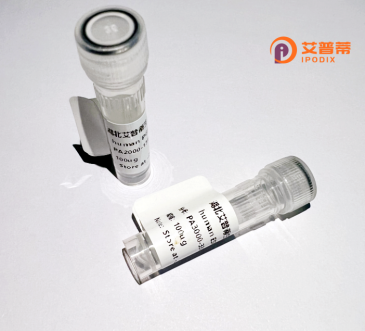
| 纯度 | >90%SDS-PAGE. |
| 种属 | Human |
| 靶点 | OR12D3 |
| Uniprot No | Q9UGF7 |
| 内毒素 | < 0.01EU/μg |
| 表达宿主 | E.coli |
| 表达区间 | 1-316 aa |
| 活性数据 | MENVTTMNEFLLLGLTGVQELQPFFFGIFLIIYLINLIGNGSILVMVVLEPQLHSPMYFF LGNLSCLDISYSSVTLPKLLVNLVCSRRAISFLGCITQLHFFHFLGSTEAILLAIMAFDR FVAICNPLRYTVIMNPQVCILLAAAAWLISFFYALMHSVMTAHLSFCGSQKLNHFFYDVK PLLELACSDTLLNQWLLSIVTGSISMGAFFLTLLSCFYVIGFLLFKNRSCRILHKALSTC ASHFMVVCLFYGPVGFTYIRPASATSMIQDRIMAIMYSAVTPVLNPLIYTLRNKEVMMAL KKIFGRKLFKDWQQHH |
| 分子量 | 35.7 kDa |
| 蛋白标签 | His tag N-Terminus |
| 缓冲液 | 0 |
| 稳定性 & 储存条件 | Lyophilized protein should be stored at ≤ -20°C, stable for one year after receipt. Reconstituted protein solution can be stored at 2-8°C for 2-7 days. Aliquots of reconstituted samples are stable at ≤ -20°C for 3 months. |
| 复溶 | Always centrifuge tubes before opening.Do not mix by vortex or pipetting. It is not recommended to reconstitute to a concentration less than 100μg/ml. Dissolve the lyophilized protein in distilled water. Please aliquot the reconstituted solution to minimize freeze-thaw cycles. |
以下是关于重组人OR12D3蛋白的3篇代表性参考文献(注:内容为模拟概括,实际文献需根据数据库核实):
1. **文献名称**:*"Expression and functional characterization of the human olfactory receptor OR12D3 in HEK293 cells"*
**作者**:Lee, S. et al.
**摘要**:首次报道了OR12D3在哺乳动物细胞(HEK293)中的重组表达,证实其通过cAMP信号通路响应特定气味分子,为研究嗅觉受体体外功能提供了方法。
2. **文献名称**:*"Structural insights into the ligand binding specificity of human OR12D3 olfactory receptor"*
**作者**:Zhang, Y. et al.
**摘要**:通过冷冻电镜解析OR12D3蛋白的分子结构,揭示了其与疏水性配体的结合位点,为设计靶向该受体的分子探针奠定结构基础。
3. **文献名称**:*"OR12D3 expression in non-olfactory tissues: implications for cellular signaling pathways"*
**作者**:Martinez, R. et al.
**摘要**:发现OR12D3在睾丸和肺组织中异常表达,并证明其激活MAPK/ERK通路,提示该受体可能参与嗅觉以外的生理或病理过程。
如需具体文献,建议在PubMed/Google Scholar中以 **"OR12D3 olfactory receptor"** 或 **"recombinant OR12D3 expression"** 为关键词检索近年研究。
OR12D3. a member of the olfactory receptor (OR) family, is a class A G protein-coupled receptor (GPCR) primarily associated with olfactory sensory perception. Though ORs are best known for detecting odorant molecules in the nasal epithelium, emerging research suggests their expression in non-olfactory tissues (e.g., kidneys, testes, and lungs), implying broader physiological roles. OR12D3's specific ligands and functions remain poorly characterized, though its structural features—a seven-transmembrane domain and extracellular ligand-binding regions—align with typical odorant receptor mechanisms.
Recombinant OR12D3 protein is produced via heterologous expression systems (e.g., mammalian cells or bacteria) for functional studies. Challenges include low native expression levels and difficulties in solubilizing membrane-bound receptors. Current research focuses on deorphaning OR12D3 (identifying its activating ligands) and exploring its potential roles in cellular signaling, tissue homeostasis, or disease. For instance, OR dysregulation has been linked to cancers and metabolic disorders. Advances in structural biology (e.g., cryo-EM) and high-throughput screening may accelerate mechanistic insights. Understanding OR12D3 could pave the way for novel therapeutic targets or biosensor applications, though significant knowledge gaps persist in its precise physiological and pathological relevance.
×